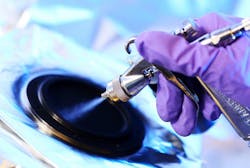Surrey NanoSystems partners with Santa Barbara Infrared on Vantablack blackbody calibration coating
Exclusive rights to the use of ultrablack Vantablack S-VIS surface coating in blackbody calibration sources has been agreed between Surrey NanoSystems (Newhaven, England) and Santa Barbara Infrared (SBIR; Santa Barbara, CA). SBIR says the broadband absorption of Vantablack S-VIS makes it ideally suited to enhancing the performance and utility of its electro-optical instrumentation, reinforcing its leadership position in military, aerospace IR/FLIR testing and simulation markets. Initially, SBIR is using Surrey NanoSystems' UK facility to apply the Vantablack coating, while it establishes a local facility to serve the North American defense, aerospace, and electro-optical markets.
RELATED ARTICLE: NASA carbon-nanotube-based optical absorber is pitch-black from UV to far-IR
SBIR president Steve McHugh said, "The superb broad band absorption of Vantablack coatings, and the highly uniform deposition layer, helps us to create blackbody sources offering extremely high radiometric performance without caveats—greatly enhancing ease of use." Surrey NanoSystems CEO David Wong adds, "We're really pleased to have Vantablack recognised by SBIR, who have a reputation built-on performance and precision. We’re also delighted to have a partner to simplify procurement and provide local support for Vantablack coatings in North America. We see this as crucial to serving such an important market."
Surrey NanoSystems' Vantablack is the world's blackest surface coating material for the UV to FIR spectrum. It uses an innovative nanomaterial structure that absorbs virtually all incident light. Vantablack was developed for space-borne imaging applications and offers exceptional IR absorption and excellent thermal, mechanical, and environmental stability and has already achieved space heritage with its recent deployment on an Earth observation satellite.
The S-VIS version of Vantablack traps over 99.8% of near- and mid-infrared wavelengths hitting its surface. It is applied using a simple spraying technique before being post-processed to achieve its exceptional broad band absorption characteristics and near-perfect Lambertian performance. This absorption is maintained over a wide-range of wavelengths and viewing angles, far-outstripping conventional black paints and other vacuum-deposited coatings. These characteristics are critical for SBIR's specialized equipment, where compliance with rigorous US defense standards, long-term stability, and traceable precision are essential attributes.
The active element of Vantablack S-VIS is a functionalized carbon nanotube matrix. The coating is applied using a proprietary process that includes a number of pre- and post-application steps to achieve its ultralow reflectance. The process is scalable and suitable for high-volume production on both small and large substrates, and on complex 3D surfaces. Vantablack S-VIS can be applied to a variety of substrates, with the only major constraint being the ability of the substrate to withstand process temperatures of 100-150 degrees Centigrade, making the coating suitable for application onto many popular types of engineering-grade polymers and composite materials.
Since its launch in spring 2016, well over 100 Vantablack S-VIS projects have already been completed, including in space-borne instrumentation and military optical systems.
Vantablack is a registered trademark of Surrey NanoSystems
SOURCE: Surrey NanoSystems; https://www.surreynanosystems.com/media/news

Gail Overton | Senior Editor (2004-2020)
Gail has more than 30 years of engineering, marketing, product management, and editorial experience in the photonics and optical communications industry. Before joining the staff at Laser Focus World in 2004, she held many product management and product marketing roles in the fiber-optics industry, most notably at Hughes (El Segundo, CA), GTE Labs (Waltham, MA), Corning (Corning, NY), Photon Kinetics (Beaverton, OR), and Newport Corporation (Irvine, CA). During her marketing career, Gail published articles in WDM Solutions and Sensors magazine and traveled internationally to conduct product and sales training. Gail received her BS degree in physics, with an emphasis in optics, from San Diego State University in San Diego, CA in May 1986.
